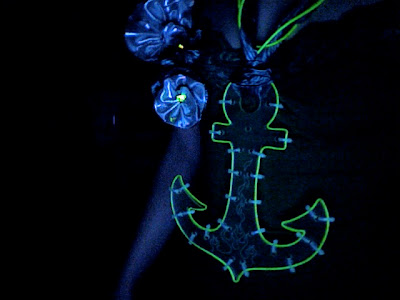Photo: Daniela Morell
Costuming is inspirational and the recent Disorient Bioluminscent boat party hit the right spot. My graduate work lately has been focused on a highly technological approach to daylighting but personally I love to shine in the dark.
Daylighting is a no-brainer for sustainable design but night lighting is a little trickier. When the sun is luminescent let's use it (lux saves bucks). When it's not the electrical world is a cultural judgment call on how we choose to use resources. I can't pretend that this jewelry serves anything more than an emotional need for folly, attention, and figuring out how to make things, but it's worth questioning how and why we use electricity at night. Indoors night lighting feels indispensable. Camping aside, I can't think of a single day of my life I haven't come home after school or work and turned on a light, or a computer, or a television. Yet none of that is inevitable.
Outdoors is another story. There are places in this world (Black Rock City) with tons of people and no electric grid. If you are not personally illuminated in the dark you might get run over. It's interesting to think about the potential of space dominated by personal instead of urban lighting. Would we become more like targets for preditors or like fireflies attracting lovers?
These are dangling questions for me that will be explored further. In the meantime I'm brimming with ideas for more light art. The array pictured above has several innovative features from previous attempts including a means to switch off the LED corsages and the use of machined plexi as an electroluminscent wire substrate. Next I'm hoping to figure out how to make a more streamlined inverter and maybe learn how to program some blinky.
[Just a quick addendum... energy savings from daylighting of course need to be balanced with the potential for increased heat gain.]
*Heating, Cooling, Lighting: Sustainable Design Methods for Architects, 3rd edition, Norbert Lechner, (c) John Wiley & Sons, Inc, 2009, p370.

No comments:
Post a Comment